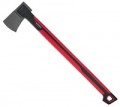Classic types of axes include
universal tools, as well as
cleavers. In addition, more specific varieties are also produced:
tourist and
tactical models, tomahawks (essentially
copies of battle axes), as well as cutting tools. Here is a more detailed description of each of these varieties:
- Universal. Traditional household axes. Quite varied in length and weight - from small hatchets, approaching tourist models, to long and heavy tools, which are only a little short of cleavers. However, all products of this type have two common features. Firstly, they are designed for standard tasks like cutting branches and trees. Secondly, even the most compact models are not designed to be carried with you all the time; A universal ax can be carried in a car, but for hiking it is better to choose a specialized hiking tool.
- Cleaver. Axes specially designed for chopping wood. They are distinguished by their large length and weight, as well as a fairly thick wedge-shaped blade. This design allows you to effectively cope even with thick logs, stumps, etc.; but for work that requires precision and accuracy, axes are not suitable.
- Tourist. Compact hatchets designed to be convenient to carry with you all the time, especially during hiking and cycling trips; Some models even have the abilit
...y to attach to a belt. Due to their small size, travel tools are inferior to universal ones in terms of impact force and overall capabilities. Nevertheless, such an ax can easily cope with most tasks relevant to a tourist: preparing firewood for a fire, sharpening and hammering tent pegs, clearing a parking lot from bushes and small trees, etc. And compactness and portability for this application are key factors.
- Tactical. Axes (usually quite small) designed based on tools used in military and police special forces (and sometimes originally created for such use and only then released to the civilian market). We emphasize that despite their origin and “aggressive” appearance, such products are primarily household tools and do not belong to edged weapons. In addition to appearance, one of the characteristic features of tactical axes is their one-piece design: the ax and handle are made of one piece of metal, and the handle is complemented with polymer/rubber pads or wrapped with paracord for ease of holding. Tools of this type are often equipped with cases for ease of carrying (including, in some models, on the belt); Also quite a popular function is the pike (pecker).
- Tomahawk. Axes copied from Indian tomahawks. The specific degree of reliability may vary: some models are almost indistinguishable from historical prototypes, others are closer to tourist or even tactical products. However, modern tomahawks are generally considered to be replicas of battle axes; They are intended primarily for connoisseurs of historical instruments in a characteristic style. At the same time, the specific dimensions, purpose and capabilities of the “tomahawk” may be different: some of them are quite suitable for “household use”, others will be useful when going out into nature or on a hike, etc. There are also more specific options - for example, axes, specially created for throwing competitions.
- Cutting. A rather rare variety is axes for chopping large pieces of meat, including whole carcasses. They differ from kitchen cleavers in both their larger size and shape: a chopping ax has a rounded blade of quite long length and weight. It is convenient to use such a tool to deliver powerful blows during the initial cutting of meat, but it is easier to disassemble the resulting pieces into smaller portions with a cleaver or other relatively small device.The weight of the ax blade, excluding the handle.
It is believed that such an ax balance is optimal when its centre of gravity is maximally shifted to the blade. Accordingly, the more massive the blade relative to the handle, the closer the centre of gravity will be to it and the closer the balance will be to the perfect. At the same time, it is impossible to infinitely make the blade heavier and lighten the handle — there are limitations associated primarily with the strength of the structure. As a result, in axes weighing up to 1.5 kg, the weight of the handle is usually 200 – 250 g; in other words, the blade accounts for about 80 – 85% of the total weight of the tool. In more massive products, the handles turn out to be heavier — for example, with a weight of 3 kg, the weight of the handle can be about a kilogram, that is, the blade already accounts for only about 60% of the weight of the tool. However, such axes usually have a considerable length, which compensates for this moment.

